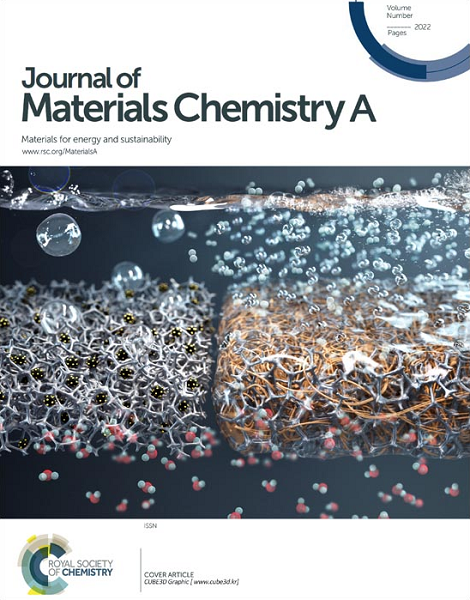Atomic-level Insights into the Highly Conductive Lithium Thio-phosphate Solid Electrolytes with Exceptional Stability Against Lithium Metal
IF 10.7
2区 材料科学
Q1 CHEMISTRY, PHYSICAL
引用次数: 0
Abstract
Despite the wide range of emerging solid electrolytes with promising characteristics, such as high ionic conductivity, the inherent thermodynamic instability against lithium metal remains a significant challenge. We have previously introduced a new family of solid electrolytes based on thiophosphates with inherent stability against metallic Li anode and high conductivity [Szczuka et al., JACS, 2022, 144 (36)]. In this study, we employ density functional theory (DFT) together with ab initio molecular dynamics (AIMD) simulations to investigate the diffusion mechanisms and underlying factors contributing to the high ionic conductivity of these novel Li-P-S ternary electrolytes, including Li7PS2, Li5PS, Li8P2S, and Li11P3S. Our findings reveal that these materials exhibit ionic conductivities comparable to the well-known superionic conductor, Li7P3S11, positioning them as promising candidates for solid-state battery applications. Additionally, we show that, unlike Li7P3S11 which forms a solid-electrolyte interphase, the novel Li-P-S ternaries exhibit remarkable stability against Li metal anode due to their unique Li2S-like structural framework. The absence of a solid-electrolyte interphase layer is particularly significant, as it eliminates additional resistance at the electrolyte-anode interface, a common challenge in many solid-state battery systems. Our study not only highlights the suitability of these novel ternaries, particularly Li5PS, as high-performance solid electrolytes but also underscores the importance of structural design in developing next-generation battery materials. The ability of these materials to maintain high ionic conductivity and stability over extended periods makes them ideal candidates for future solid-state lithium batteries, offering a pathway to safer, more efficient, and longer-lasting energy storage solutions.具有优异稳定性的高导电性硫代磷酸锂固体电解质在原子水平上的洞察
尽管新兴的固体电解质具有各种有前途的特性,如高离子电导率,但对锂金属固有的热力学不稳定性仍然是一个重大挑战。我们之前已经介绍了一种基于硫代磷酸盐的新型固体电解质,该电解质对金属锂阳极具有固有的稳定性和高导电性[Szczuka等人,JACS, 2022, 144(36)]。在这项研究中,我们采用密度泛函理论(DFT)和从头算分子动力学(AIMD)模拟来研究Li7PS2、Li5PS、Li8P2S和Li11P3S这些新型锂-磷- s三元电解质的扩散机制和影响其高离子电导率的潜在因素。我们的研究结果表明,这些材料具有与著名的超离子导体Li7P3S11相当的离子导电性,使它们成为固态电池应用的有前途的候选者。此外,我们表明,与Li7P3S11形成固体电解质界面不同,由于其独特的li2s结构框架,新型Li- p - s三元体对锂金属阳极表现出显着的稳定性。固体电解质界面层的缺失尤其重要,因为它消除了电解质-阳极界面的额外电阻,这是许多固态电池系统中常见的挑战。我们的研究不仅强调了这些新型三元化合物,特别是Li5PS,作为高性能固体电解质的适用性,而且强调了结构设计在开发下一代电池材料中的重要性。这些材料在较长时间内保持高离子电导率和稳定性的能力使其成为未来固态锂电池的理想候选材料,为更安全、更高效、更持久的能量存储解决方案提供了一条途径。
本文章由计算机程序翻译,如有差异,请以英文原文为准。
求助全文
约1分钟内获得全文
求助全文
来源期刊

Journal of Materials Chemistry A
CHEMISTRY, PHYSICAL-ENERGY & FUELS
CiteScore
19.50
自引率
5.00%
发文量
1892
审稿时长
1.5 months
期刊介绍:
The Journal of Materials Chemistry A, B & C covers a wide range of high-quality studies in the field of materials chemistry, with each section focusing on specific applications of the materials studied. Journal of Materials Chemistry A emphasizes applications in energy and sustainability, including topics such as artificial photosynthesis, batteries, and fuel cells. Journal of Materials Chemistry B focuses on applications in biology and medicine, while Journal of Materials Chemistry C covers applications in optical, magnetic, and electronic devices. Example topic areas within the scope of Journal of Materials Chemistry A include catalysis, green/sustainable materials, sensors, and water treatment, among others.
 求助内容:
求助内容: 应助结果提醒方式:
应助结果提醒方式:


